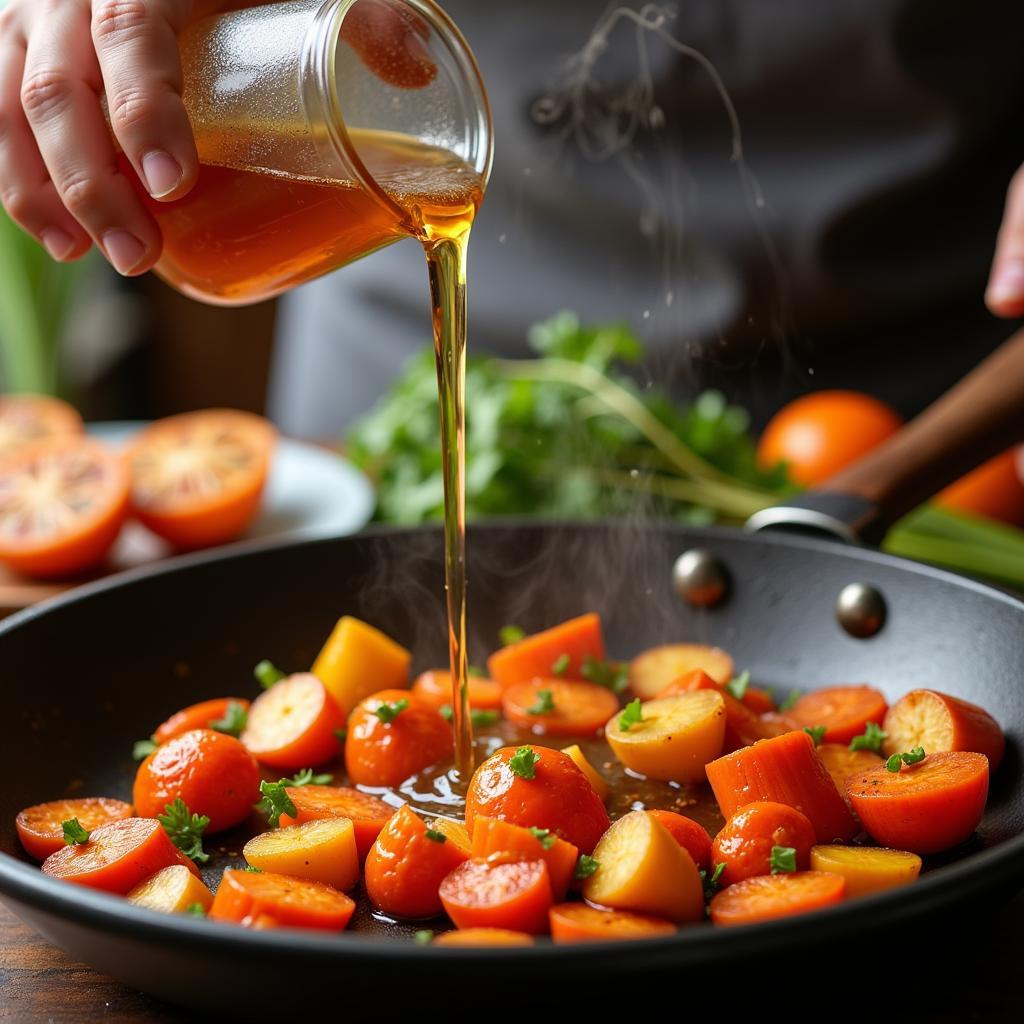“Add Liquid To Food Residue” might sound simple, but it’s the foundation for countless culinary creations. From revitalizing yesterday’s roast to building flavorful soups and sauces, mastering this technique unlocks a world of possibilities in the kitchen. Whether you’re a seasoned chef or a cooking novice, understanding the nuances of adding liquid to leftover food can elevate your dishes from ordinary to extraordinary.
 Adding Broth to Roasted Vegetables
Adding Broth to Roasted Vegetables
Why Add Liquid to Food Residue?
The magic happens when you add liquid to a pan that once held roasted meats, vegetables, or even simmered sauces. Those browned bits and caramelized edges, often referred to as “fond,” are packed with concentrated flavor. Deglazing, the process of adding liquid and scraping up the fond, releases these flavorful compounds, forming the base for rich gravies, pan sauces, and soups.
Choosing the Right Liquid
The liquid you choose depends on the flavor profile you want to achieve and the dish you’re creating.
- Water: A neutral option for deglazing, water creates a light sauce perfect for thinning down thicker residues.
- Broth or Stock: These flavorful liquids add depth and complexity, enhancing the taste of your final dish. Choose a broth that complements the food residue, like chicken broth for poultry residues or vegetable broth for a vegetarian option.
- Wine: Often used in deglazing, wine adds acidity and complexity. Red wine pairs well with beef and lamb, while white wine complements chicken and fish.
- Fruit Juice: Tart fruit juices like apple or orange juice can balance richness in pan sauces, especially for pork or duck dishes.
Techniques for Adding Liquid
The way you add liquid impacts the final result.
- Deglazing: After cooking, remove excess fat from the pan. Add your chosen liquid to the hot pan and scrape the bottom with a wooden spoon to lift the fond.
- Simmering: For deeper flavors, simmer the liquid and food residue together for a longer time, allowing the flavors to meld and intensify.
- Blending: For smooth sauces and soups, transfer the liquid and food residue to a blender and blend until smooth.
Creative Applications
The possibilities are endless when you embrace the art of adding liquid to food residue.
- Transform Roasted Vegetables: Turn last night’s roasted vegetables into a comforting soup by adding vegetable broth and blending.
- Elevate Leftover Chicken: Create a flavorful sauce for pasta by deglazing the pan with white wine and chicken broth, then tossing with shredded chicken and your favorite pasta.
- Make the Most of Pan Drippings: Those precious pan drippings from a roast become a luxurious gravy with the addition of broth and a touch of flour for thickening.
Tips for Success
- Use the Right Pan: Stainless steel or cast iron pans work best for deglazing as they distribute heat evenly and promote browning.
- Don’t Crowd the Pan: Overcrowding prevents proper browning. Cook food in batches if needed.
- Control the Heat: Deglaze over medium heat to avoid scorching the fond.
- Season to Taste: Always taste and adjust seasonings after adding liquid and simmering.
Conclusion
Adding liquid to food residue is a simple yet transformative technique that can elevate your cooking to new heights. By understanding the principles of deglazing and experimenting with different liquids and techniques, you can unlock a world of flavor and turn simple leftovers into culinary masterpieces.
FAQs
1. Can I add liquid to food residue even if it’s stuck to the pan?
Absolutely! The key is to deglaze while the pan is still hot. The heat helps to loosen the stuck-on bits. If needed, you can let the pan soak in hot water for a few minutes before deglazing.
2. What if my sauce is too thin after adding liquid?
You can thicken the sauce by creating a slurry. Mix a tablespoon of cornstarch or flour with an equal amount of cold water and whisk it into the simmering sauce. Continue to cook until the sauce reaches your desired consistency.
3. Can I use this technique for vegetarian or vegan dishes?
Of course! Vegetable broth, wine, and fruit juices are all excellent options for deglazing and creating flavorful vegetarian and vegan sauces and soups.
4. How do I store leftover sauces made from food residue?
Allow the sauce to cool completely, then transfer it to an airtight container and store it in the refrigerator for up to 3 days. You can also freeze the sauce for longer storage.
5. What are some other creative ways to use food residue?
Food spray can be used to prevent food residue from sticking in the first place. You can also use food residue to make flavorful stocks, incorporate it into compound butters, or even spread it on toast for a savory snack.
Still Have Questions?
For personalized advice on adding liquid to food residue or any other culinary queries, don’t hesitate to reach out to our team at Mina Cones Food. Contact us at 02437655121, email us at [email protected], or visit us at 3PGH+8R9, ĐT70A, thôn Trung, Bắc Từ Liêm, Hà Nội, Việt Nam. We’re here to help you unleash your inner chef, one delicious dish at a time.